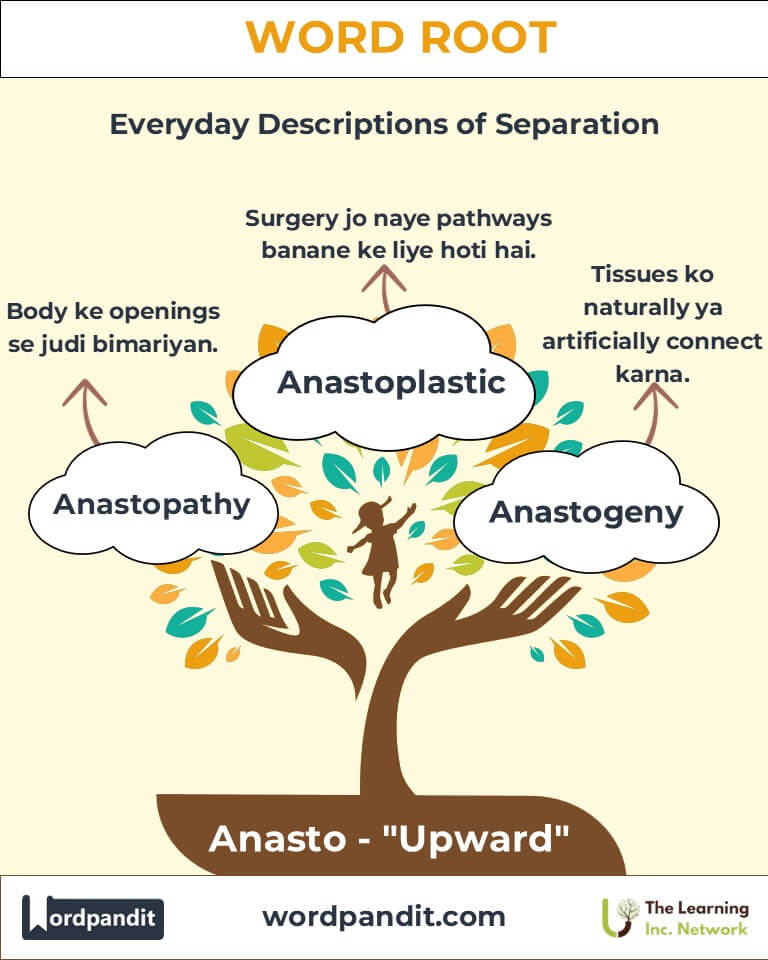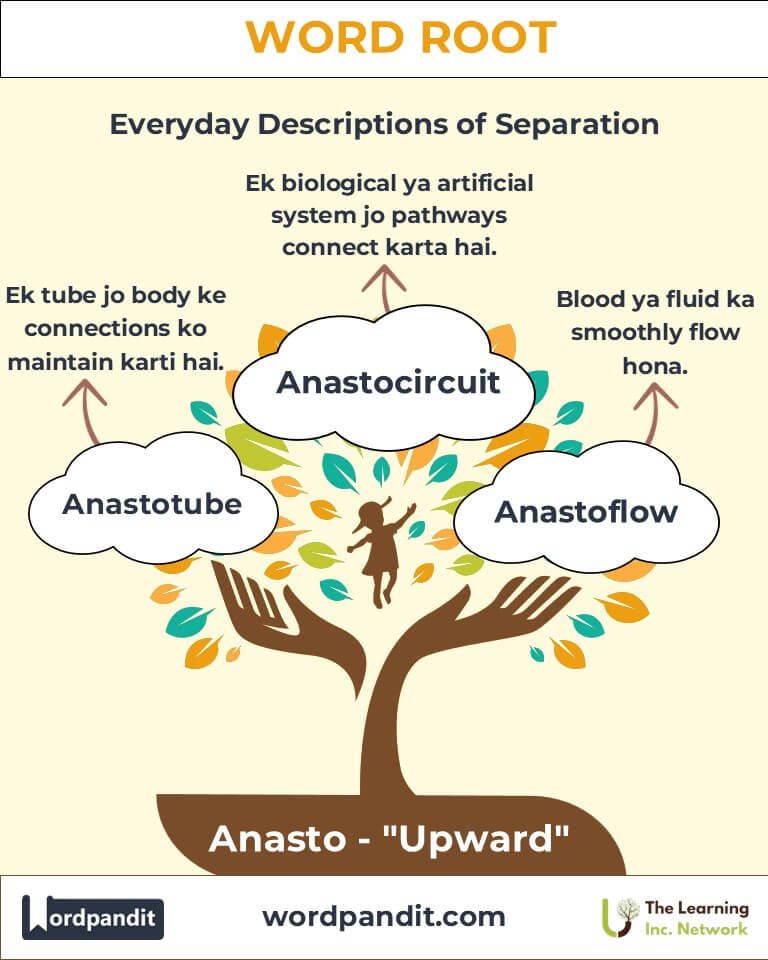Anasto: Bridging Life Through Openings in Medicine and Beyond
Discover the profound significance of the root "Anasto," meaning "opening." Learn how it forms the basis of vital medical terminology like "anastomosis" and "anastomotic," and its role in creating pathways for connection and healing across disciplines.

Table of Contents
- Introduction: The Essence of "Anasto"
- Etymology and Historical Journey
- Mnemonic: Unlocking the Power of "Anasto"
- Common Anasto-Related Terms
- "Anasto" Through Time
- "Anasto" in Specialized Fields
- Illustrative Story: "Anasto" in Action
- Cultural Significance of the "Anasto" Root
- The "Anasto" Family Tree
- FAQs about the "Anasto" Word Root
- Test Your Knowledge: "Anasto" Word Root Quiz
- Conclusion: The Living Legacy of "Anasto"
Introduction: The Essence of "Anasto"
Imagine the life-saving pathways that connect organs, restore blood flow, or repair critical tissues. The root "Anasto," derived from Greek, meaning "opening," forms the foundation for medical terms emphasizing connections and pathways. Pronounced “uh-NAS-toh,” this root plays a crucial role in medicine, biology, and engineering, symbolizing the creation of essential connections.

Etymology and Historical Journey
The word root "Anasto" originates from the Greek word anastomosis, which means "providing an opening" or "outlet." First used in anatomical and surgical contexts in ancient Greece, the term was adopted into Latin as anastomosis. During the Renaissance, as medical sciences advanced, this root became central to describing complex surgical procedures that created connections within the body.
Mnemonic: Unlocking the Power of "Anasto"
Visualize a bridge connecting two isolated islands, allowing life and activity to flow between them. Similarly, "Anasto" opens pathways for reconnection and function.
Mnemonic Device: "Anasto—where openings restore life’s flow and connections grow."
Common Anasto-Related Terms
- Anastomosis (uh-NAS-tuh-moh-sis)
- Definition: A surgical connection between two structures, often blood vessels or intestines.
- Example: "The surgeon performed an anastomosis to restore blood flow after the blockage."
- Anastomotic (uh-NAS-tuh-MAH-tik)
- Definition: Relating to or involving an anastomosis.
- Example: "Anastomotic leakage is a potential complication in gastrointestinal surgeries."
- Anastomose (uh-NAS-tuh-mohz)
- Definition: To connect or join by an anastomosis.
- Example: "The capillaries anastomose to form a dense network of blood supply."
- Anastomotic Channel
- Definition: A naturally occurring or surgically created channel that provides an alternative route.
- Example: "Anastomotic channels were crucial in maintaining blood flow after the blockage."
"Anasto" Through Time
- Ancient Usage: In early anatomy studies, "Anasto" described natural connections in blood vessels.
- Modern Evolution: With advancements in surgical techniques, "Anasto" terms now refer to sophisticated procedures like coronary artery bypass grafting.
"Anasto" in Specialized Fields
- Medicine:
- Term: Anastomosis
- Application: Used in surgeries to connect vessels or intestines, ensuring restored function.
- Biology:
- Term: Anastomotic Veins
- Application: Describes veins providing alternative pathways for blood flow.
- Engineering:
- Term: Anastomotic Networks
- Application: Networks mimicking natural connections, often used in hydrology or electrical systems.
Illustrative Story: "Anasto" in Action
Dr. Olivia, a renowned cardiovascular surgeon, faced a high-stakes operation. Her patient’s arteries were severely blocked, threatening their life. Using an advanced anastomosis technique, she bypassed the blockages, restoring blood flow. Watching the heart beat strongly after the procedure, Dr. Olivia reflected on the profound significance of "Anasto"—creating openings to sustain life.
Cultural Significance of the "Anasto" Root
"Anasto" transcends its medical origins, symbolizing reconnection and restoration in various contexts. From bridging divides in communities to inspiring problem-solving in technology, "Anasto" reminds us of the importance of opening pathways for progress and healing.

The "Anasto" Family Tree
- Stoma (Greek, "mouth/opening"):
- Example: Colostomy (surgical opening in the colon).
- Poro (Greek, "passage"):
- Example: Porosity (presence of pathways for fluid flow).
- Tom (Greek, "to cut"):
- Example: Laparotomy (a surgical incision into the abdominal cavity).

FAQs About " Anasto "
Q: What does "Anasto" mean?
A: "Anasto" is derived from the Greek word anastomosis, meaning "opening" or "connection." It refers to creating a passage or linkage between two structures, often used in medical contexts to describe surgical or natural connections, such as blood vessels or ducts.
Q: What is an anastomosis?
A: An anastomosis is a surgical or naturally occurring connection between two structures, such as blood vessels, intestines, or ducts. For instance, in cardiovascular surgery, an anastomosis might connect arteries to bypass blockages, ensuring blood flow continues.
Q: How is "Anasto" used outside medicine?
A: Beyond medicine, "Anasto" appears in engineering, biology, and hydrology. For example, in hydrology, an anastomotic network refers to interconnected rivers or channels, mimicking natural blood vessel patterns to manage water flow.
Q: What are anastomotic veins?
A: Anastomotic veins are veins that provide alternative pathways for blood circulation, especially when primary veins are obstructed. This redundancy in circulation ensures the body can maintain blood flow even under compromised conditions.
Q: What is an anastomotic leak?
A: An anastomotic leak is a complication in surgeries involving connections, where the joined site fails to seal completely. This can lead to leakage of fluids, requiring immediate medical intervention to prevent infections or other complications.
Q: Is "Anasto" related to natural bodily functions?
A: Yes, many natural processes involve "Anasto." For example, in the circulatory system, capillaries anastomose to form networks that ensure blood reaches all tissues. This interconnection is vital for efficient oxygen and nutrient delivery.
Q: What is the significance of anastomosis in regenerative medicine?
A: In regenerative medicine, anastomosis is critical for integrating transplanted or artificial tissues with the body’s natural systems. Creating vascular anastomoses helps ensure the survival of transplanted tissues by establishing blood supply.
Test Your Knowledge: " Anasto " Mastery Quiz
1. What does "Anasto" signify?
2. Which term refers to a surgical connection?
3. What is an anastomotic channel?
4. What does "Anasto" originate from?
5. Which biological process involves natural anastomoses?
Conclusion: The Living Legacy of "Anasto"
The root "Anasto" embodies the concept of creating vital connections, whether in the human body or technological systems. Its applications in medicine, biology, and beyond remind us of the importance of openings—both literal and metaphorical—in fostering life and innovation. As science advances, "Anasto" continues to inspire pathways for healing and growth, affirming its timeless relevance.












